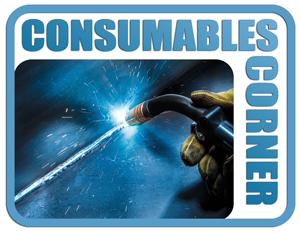Independent welding consumables professional
- FMA
- The Fabricator
- FABTECH
- Canadian Metalworking
Categories
- Additive Manufacturing
- Aluminum Welding
- Arc Welding
- Assembly and Joining
- Automation and Robotics
- Bending and Forming
- Consumables
- Cutting and Weld Prep
- Electric Vehicles
- En Español
- Finishing
- Hydroforming
- Laser Cutting
- Laser Welding
- Machining
- Manufacturing Software
- Materials Handling
- Metals/Materials
- Oxyfuel Cutting
- Plasma Cutting
- Power Tools
- Punching and Other Holemaking
- Roll Forming
- Safety
- Sawing
- Shearing
- Shop Management
- Testing and Measuring
- Tube and Pipe Fabrication
- Tube and Pipe Production
- Waterjet Cutting
Industry Directory
Webcasts
Podcasts
FAB 40
Advertise
Subscribe
Account Login
Search
Consumables Corner: The relationship between ferrite numbers and cracking
- By Nino Mascalco, Rob Koltz, and Steve Sigler
- November 19, 2018
- Article
- Consumables
Q: We recently started doing work that requires some components to be manufactured from mostly 304-grade stainless steel, which is welded to itself and to mild steel. We've experienced some cracking issues on the stainless-to-stainless welded sections that are up to 1.25 inches thick. It was mentioned that our ferrite numbers are low. Can you explain what this is and how to correct the issue?
A: That's a great question. And yes, we can help you understand what it means to have low ferrite numbers and how to prevent it.
First, let's review what defines a stainless steel (SS) and then how ferrite relates to the welded joints. Ferrous steels and alloys contain more than 50 percent iron. This includes all carbon and stainless steels as well as other defined groups. Aluminum, copper, and titanium don’t contain iron, so they are great examples of nonferrous alloys.
The primary constituent of the alloy is iron content of at least 90 percent for carbon steel and 70 to 80 percent for SS. To be classified as a SS, it must have a minimum of 11.5 percent chromium added to it. Chrome content higher than this minimum threshold promotes the formation of a chrome-oxide film on the surface of the steel and prevents oxidation formation, such as rust (iron oxide), or corrosion due to chemical attack.
There are three primary groups of SS: austenitic, ferritic, and martensitic. Their names are derived from the room-temperature crystalline structures that make them up. Another common group is duplex SS, which is a balance between ferrite and austenite in the crystalline structure.
Austenitic grades, which are the 300 series, contain 16 to 30 percent chromium and 8 to 40 percent nickel, forming a dominant austenite crystalline structure. To promote the formation of an austenite-ferrite ratio, stabilizers such as nickel, carbon, manganese, and nitrogen are added during the steelmaking process. Some common grades are 304, 316, and 347. This group is nonmagnetic; provides good corrosion resistance; and is used primarily in food, chemical service, pharmaceutical, and cryogenic applications. The control of the formation of ferrite provides superior cold-temperature toughness.
Ferritic SS, the 400 series grades, are fully magnetic and contain 11.5 to 30 percent chromium with the primary crystalline structure as ferrite. To promote the formation of ferrite, stabilizers include chromium, silicon, molybdenum, and niobium during steel production. These types of SS are commonly used for automotive exhaust systems and power plants and have limited elevated-temperature application. A few commonly used types are 405, 409, 430, and 446.
Martensitic grades, also identified by the 400 series such as 403, 410, and 440, are magnetic, contain 11.5 to 18 percent chromium, and have martensite as the crystalline structure. This group contains the lowest amount of alloy, which makes them the cheapest to produce. They provide some corrosion resistance; excellent strength; and are typically used for cutlery, dental and surgical equipment, cookware, and some types of tools.
When you weld SS, the base material type and its in-service application will determine the proper filler metal to use. If you are using a gas-shielded process, you may have to pay special attention to the shielding gas blend to prevent certain weld-related issues.
For welding 304 to itself, you'll want to use an E308/308L electrode. The "L" designator represents low carbon, which can help prevent intergranular corrosion. These electrodes have carbon content of less than 0.03 percent; anything greater than that will increase the risk of carbon precipitating to the grain boundaries and bonding with the chromium to form chrome carbides, which effectively reduces the corrosion resistance of the steel. This can become apparent if there is corrosion in the heat-affected zone (HAZ) of a SS welded joint. One other consideration with L grade SS is they have a lower tensile strength in elevated service temperatures versus the straight SS grade.
Since 304 is an austenitic type of SS, the corresponding weld metal will contain a majority of austenite. However, the welding electrode itself will have ferrite stabilizers in it, such as molybdenum, to promote the formation of ferrite in the weld metal. The manufacturer will usually list a typical ferrite number range of the weld metal. As mentioned before, carbon is a strong austenite stabilizer, and for these reasons preventing the addition of carbon to the weld metal is critical.
Ferrite numbers are derived from the Schaeffler diagram and the WRC -1992 diagram that utilize nickel and chromium equivalency formulas to calculate values, which when plotted on the diagrams produce a standardized number. Ferrite numbers between 0 and 7 correspond to the volume percentage of ferrite crystalline structure present in the weld metal; however, at higher percentages the ferrite number increases at a faster rate. Keep in mind the ferrite within SS is not the same as carbon steel ferrite but is instead a phase known as delta-ferrite. Austenitic SS does not have phase changes associated with high-temperature processes such as heat treating.
Ferrite formation is desirable as it is more ductile than austenite, but it must be controlled. Low ferrite numbers can produce a weld that has superior corrosion resistance in certain applications but is highly susceptible to hot cracking during welding. The ferrite number should fall between 5 and 10 for general service conditions, but lower or higher values might be desired for some applications. The ferrite can be readily verified on the job using a ferrite indicator.
Since you mentioned you are having cracking issues and low ferrite numbers, you'll want to take a close look at your filler metal and make sure it produces an adequate ferrite number—something around 8 should help. Also, if you are flux-core arc welding (FCAW), those filler metals typically use 100 percent carbon dioxide shielding gas or a blend of 75 percent argon/25 percent CO2, and that can lead to carbon pickup in the weld metal. You may want to switch to a gas metal arc welding (GMAW) process and use a 98 percent argon/2 percent oxygen blend to reduce the possibility of carbon pickup.
To weld SS to carbon steel, you'll have to use an E309L filler material. This filler metal is specially formulated to weld dissimilar metals, offering some amount of ferrite formation after the dilution of carbon steel into the weld. Since there will be some carbon pickup from the carbon steel, ferrite stabilizers are added to the filler metal to counter the carbon's tendency to form austenite. This will help prevent hot cracking during welding applications.
To summarize, if you're trying to eliminate hot cracking on austenitic SS welded joints, verify an adequate ferrite number filler metal and follow good welding practices. Keep your heat input below 50 kJ/inch, maintain a moderate to low interpass temperature, and make sure the weld joints are free of all contaminants before welding. Verify the ferrite number on the welded joints using appropriate gauges with a target of 5 to 10.
About the Authors


Rob Koltz
Application Engineer
411 S. Ebenezer Rd.
Florence, 29501
636-485-2253
Steve Sigler
Application Engineer
411 S. Ebenezer Rd.
Florence, South Carolina 29501
636-485-2253
About the Publication
Related Companies
subscribe now

The Welder, formerly known as Practical Welding Today, is a showcase of the real people who make the products we use and work with every day. This magazine has served the welding community in North America well for more than 20 years.
start your free subscription- Stay connected from anywhere

Easily access valuable industry resources now with full access to the digital edition of The Fabricator.

Easily access valuable industry resources now with full access to the digital edition of The Welder.

Easily access valuable industry resources now with full access to the digital edition of The Tube and Pipe Journal.
- Podcasting
- Podcast:
- The Fabricator Podcast
- Published:
- 04/16/2024
- Running Time:
- 63:29
In this episode of The Fabricator Podcast, Caleb Chamberlain, co-founder and CEO of OSH Cut, discusses his company’s...
- Trending Articles
Sheffield Forgemasters makes global leap in welding technology

Welding student from Utah to represent the U.S. at WorldSkills 2024

Lincoln Electric announces executive appointments

Lincoln Electric acquires RedViking

Engine-driven welding machines include integrated air compressors

- Industry Events
16th Annual Safety Conference
- April 30 - May 1, 2024
- Elgin,
Pipe and Tube Conference
- May 21 - 22, 2024
- Omaha, NE
World-Class Roll Forming Workshop
- June 5 - 6, 2024
- Louisville, KY
Advanced Laser Application Workshop
- June 25 - 27, 2024
- Novi, MI



























